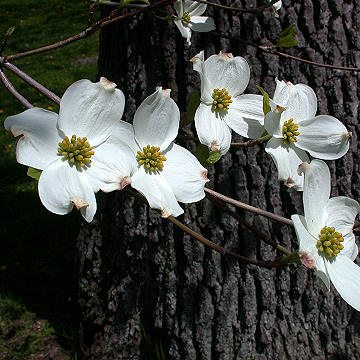

Cornus florida - (image 1 of 8)
Taxonomy
Family: Cornaceae
Habitat
Mesic woods.
Associates
Acer saccharum, Asimina triloba, Carpinus caroliniana, Fagus grandifolia, Geranium maculatum, Hamamelis virginiana, Lindera benzoin, Liriodendron tulipifera, Mianthemum canadense, Polygonatum pubescens, Quercus rubra, Ribes cynosbati, Sassafras albidum, Smilacina racemosa, Smilax rotundifolia, Solidago caesia, Ulmus americana.
Distribution
ME and southern Ontario west to MI, IL, MO and OK, south to FL and northeast Mexico.
Morphology
Wide branching small tree to 10 m; bark red-brown, rough, breaking into quadrangular plates in older specimens. Leaves opposite, ovate to elliptic or obovate, 6-10 cm and half as wide, sharply acuminate, pale below. Flowers in tight clusters, capitate, subtended by four large, white, petal-like sepals. Fruit a drupe, red, glossy, ripening in fall, several to a cluster. Flower buds form in the fall and are often present with the fruits as the leaves change.
Notes
Flowers late April to early June
Wetland indicator: Facultative Upland -
Probably the most widely planted small tree, its popularity has waned somewhat due to several problematic diseases. Such is the case with many popular landscape trees and shrubs. Flowers are large and showy. Fall color is often a brilliant red or purple-red. There are several cultivars with pink sepals. Dirr cautions that cultivars should be selected for cold hardiness in colder zones. The wood is extremely dense and hard.
References
Dirr, Michael A.
1998. Manual of Woody Landscape Plants: Their Identification, Ornamental
Characteristics, Culture, Propagation and Uses.
5th ed. Champaign, Illiois: Stipes Publishing L.L.C.
Gleason, Henry A.
and A. Cronquist. 1991. Manual of Vascular Plants of Northeastern United States
and Adjacent Canada. Second Ed.
The New York Botanical Garden. Bronx, NY
Swink, F. and G.
Wilhelm. 1994. Plants of the Chicago Region.
Indiana Academy of Science. The Morton Arboretum. Lisle, Illinois.
|
Michael Hough © 2004 |